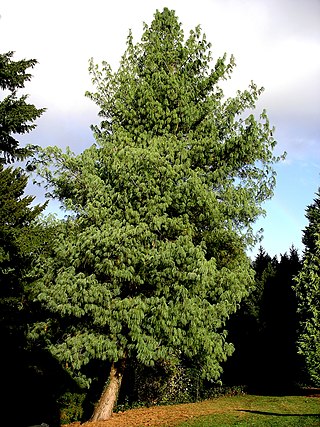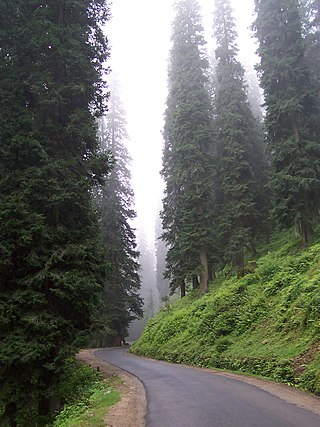Related Research Articles

Pinus wallichiana is a coniferous evergreen tree native to the Himalaya, Karakoram and Hindu Kush mountains, from eastern Afghanistan east across northern Pakistan and north west India to Yunnan in southwest China. It grows in mountain valleys at altitudes of 1800–4300 m, reaching 30–50 m (98–164 ft) in height. It favours a temperate climate with dry winters and wet summers. In Pashto, it is known as Nishtar.

Cedrus deodara, the deodar cedar, Himalayan cedar, or deodar, is a species of cedar native to the Himalayas.

Pinus gerardiana, commonly known as the chilghoza pine or neja is a pine native to the northwestern Himalayas in Afghanistan, northern Pakistan, Waziristan and northwestern India, growing at elevations of 1,800–3,350 metres (5,910–10,990 ft). It often occurs in association with Cedrus deodara and Pinus wallichiana.

Pithoragarh district is the easternmost district in the state of Uttarakhand. It is located in the Himalayas and has an area of 7,110 km2 (2,750 sq mi) and a population of 483,439. The city of Pithoragarh, located in Saur Valley, is its headquarters. The district is within the Kumaon division of Uttarakhand state. The Tibet plateau is situated to the north and Nepal is to the east. The Kali River which originates from the Kalagiri Mountain flows south, forming the eastern border with Nepal. The Hindu pilgrimage route for Mount Kailash-Lake Manasarovar passes through this district via Lipulekh Pass in the greater Himalayas. The district is administratively divided into six Tehsils: Munsyari; Dharchula; Didihat; Berinag; Gangolihat; and Pithoragarh. Naini Saini Airport is the nearest civil airport, but it does not have a regular scheduled commercial passenger service. The mineral deposits present in the district are magnesium ore, copper ore, limestone, and slate. There are 11 tehsils.

Abies pindrow, the pindrow fir or west Himalayan fir, is a fir native to the western Himalaya and adjacent mountains, from northeast Afghanistan east through northern Pakistan and India to central Nepal.

Kishtwar National Park is a national park located, just 40 km from Kishtwar town in the Kishtwar district of Jammu and Kashmir, India. It is bounded to the north by Rinnay river, south by Kibar Nala catchment, east by main divide of Great Himalaya and west by Marwah river.

Narkanda is a town and a nagar panchayat in Kumarsain subdivision of Shimla district in the Indian state of Himachal Pradesh. It is at an elevation of 2708 meters on the Hindustan-Tibet Road in Himachal Pradesh, India within a fir forest. It is about 60 km away from Shimla and surrounded by the Himalayan Range.

The Littlefield House is a historic home in Austin, Texas, on the campus of the University of Texas at Austin. The home was built in 1893 for Civil War veteran George Littlefield, who was a successful businessman in the bank and cattle trades and a major benefactor to UT. It was designed using the popular Victorian style at a cost of $50,000.
Deodar may refer to :

Pakistan's native flora reflects its varied climatic zones, which range from arid and semi-arid to temperate and tropical.
Kazinag National Park is a commissioned future national park in Baramulla city of the Baramulla district in the Indian union territory of Jammu and Kashmir. It is part of a proposal for a trans-Karakoram peace park with Pakistan. Kazinag national park located in North region of kashmir.The area of kazinag national park is 160 sq.kms.It was commissioned in 1992 A.D.The National park is located on the north bank of river jehlum.

The Western Himalayan broadleaf forests is a temperate broadleaf and mixed forest ecoregion which is found in the middle elevations of the western Himalayas, including parts of Nepal, India, and Pakistan.

The Western Himalayan subalpine conifer forests is a temperate coniferous forests ecoregion of the middle and upper elevations of the western Middle Himalayas of Nepal, India, and Pakistan.

The forestry sector of Pakistan is a main source of lumber, paper, fuelwood, latex, medicine as well as food and provide ecotourism and wildlife conservation purposes. 4.91% of Pakistan's land is covered in forest.The Shangla district is the only district of Pakistan that composed of more than 80% of forest land

Hatu Peak is located in the Shimla district of Himachal Pradesh in India. It is one of the highest peaks in the region, standing at an elevation of 3400 m (11,152 ft) above sea level. The peak is surrounded by dense forest of conifers, oaks and maples.

Bindeshwar Mahadev Temple, also known as Binsar Devta or simply Binsar, is an ancient Hindu rock temple dedicated to Lord Shiva, worshipped as Bindeshwar, a popular deity in this region. At an altitude of 2480 meters above mean sea level, it is situated in Bisaona village, which falls in the Chauthan region of Thalisain Block in the Pauri Garhwal District of the Indian state of Uttarakhand. This temple is set amidst dense forests of birch, deodar and rhododendron. The original temple structure held great archaeological significance, but it was demolished by politicians in order to create a new structure. The central chamber of the temple features the idols of Ganesha, Shiva-Parvati and Mahishasuramardini. A fair is organized there on Vaikuntha Chaturdashi every year.

Pissodes nemorensis, known generally as the eastern pine weevil or deodar weevil, is a species of true weevil in the beetle family Curculionidae. It is found in North America and Africa. Deodar weevils are considered a forest pest in the United States, with adults and larvae feeding on a variety of coniferous tree species, including trees such as Deodar cedar, loblolly pine, longleaf pine, sand pine, shortleaf pine, slash pine, and spruce pine Trees of all ages are susceptible to weevil infestations, with trees that are severely stressed by fire, drought, extreme cold, fusiform rust, wind damage, and other problems are prone to weevil infestation. In well managed pine stands, deodar weevil infestations are sporadic, attacking only the suppressed and unhealthy trees throughout the area. Because they do not typically effect healthy trees, they do not usually alter traditional management strategies. Unlike many other forest pests in the eastern United States, deodar weevils are most active in the winter months, and this is often when sign of infestations can be seen. The best way to avoid a deodar weevil infestation is to maintain good tree and stand health, healthy trees do not typically face mortality or extensive damage from these pests. If an infestation has occurred, pesticides can be used in the fall as the weevils become active, but is typically not recommended.

The East Afghan montane conifer forests ecoregion covers a series of unconnected conifer forests along the border between Afghanistan and Pakistan, at elevations of 2,000 metres (6,600 ft) to 3,400 metres (11,200 ft) above sea level. The ecoregion supports the near-threatened Markhor (Capra falconeri chiltanensis), known as the Screw-horned goat, the national animal of Pakistan. The forests of the ecoregion have been heavily thinned for timber.

Arceuthobium minutissimum, known as the Indian dwarf mistletoe or Himalayan dwarf mistletoe, is a leafless parasitic plant of Pinus wallichiana. It is considered the smallest known dicotyledonous plant.
References
- 1 2 Mesaik, Ahmed; Nazim, Kanwal; Siddiqui, Muhammad; Wahab, Muhammad; Khan, Nazreen; Khan, Nasrullah; Hussain, Syed (2010-10-01). "Community description of Deodar forests from Himalayan range of Pakistan". Pakistan Journal of Botany. 42: 3091–3102.
- ↑ "Cedrus deodara, Oregon State Univ., LANDSCAPE PLANTS". oregonstate.edu. Retrieved 2019-10-31.
- 1 2 "Urban Forests | US Forest Service". www.fs.fed.us. Retrieved 2019-11-16.
- ↑ "1. Deodar Cedar". depts.washington.edu. Retrieved 2019-10-31.
- ↑ "Deodar Cedar | University of Redlands". Sites. Retrieved 2019-10-31.
- 1 2 "Cedrus deodara root rot disease-threat to the Himalayan forestry and environment". www.cabi.org. 2000. Retrieved 2019-11-16.
- ↑ "Deodar Forest Himachal Pradesh". 2017-12-06. Retrieved 2019-10-31.